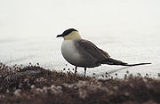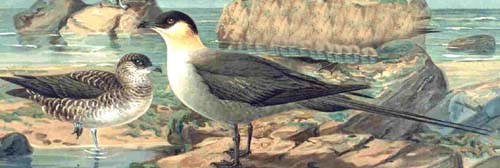
Long-tailed Skua
Encyclopedia
The Long-tailed Skua, Stercorarius longicaudus (known as the Long-tailed Jaeger in North America) is a seabird
in the skua
family Stercorariidae.
This is the smallest of the skua family at 38–58 cm (15–22.8 in), depending on season and age. However, much of this, up to 29 cm (11.4 in), is comprised by the tail which may include the 15 cm (5.9 in) tail streamers of the summer adult. The wingspan of this species ranges from 102 to 117 cm (40.2 to 46.1 in) and the body mass is 230–444 g (8.1–15.7 oz).
This species breeds in the high Arctic of Eurasia
and North America
, with major populations in Russia
, Alaska
and Canada
and smaller populations around the rest of the Arctic
. It is a migrant
, wintering in the south Atlantic
and Pacific. Passage juvenile birds sometimes hunt small prey in ploughed fields or golf-courses, and are typically quite fearless of humans.
They nest on dry tundra
or higher fells laying two spotted olive-brown eggs. On the breeding grounds they can be heard making yelping and rattling sounds. Outside of the breeding season they spend most of their time over open ocean and have a harsh kreeah cry. This bird
feeds on fish (mainly caught from other seabirds), small birds, scraps, small mammals and carrion. On migration, Long-tailed Jaegers are more likely to catch their own food, and less likely to steal from gull
s and tern
s than larger species
.
This species is unmistakable as an adult, with grey back, dark primary wing feathers without a white "flash", black cap and very long tail. Adults often hover over their breeding territories. Juveniles are much more problematic, and are difficult to separate from Parasitic Jaeger over the sea. They are slimmer, longer-winged and more tern-like than that species, but show the same wide range of plumage variation. However, they are usually colder toned than Arctic, with greyer shades, rather than brown.

Seabird
Seabirds are birds that have adapted to life within the marine environment. While seabirds vary greatly in lifestyle, behaviour and physiology, they often exhibit striking convergent evolution, as the same environmental problems and feeding niches have resulted in similar adaptations...
in the skua
Skua
The skuas are a group of seabirds with about seven species forming the family Stercorariidae and the genus Stercorarius. The three smaller skuas are called jaegers in North America....
family Stercorariidae.
This is the smallest of the skua family at 38–58 cm (15–22.8 in), depending on season and age. However, much of this, up to 29 cm (11.4 in), is comprised by the tail which may include the 15 cm (5.9 in) tail streamers of the summer adult. The wingspan of this species ranges from 102 to 117 cm (40.2 to 46.1 in) and the body mass is 230–444 g (8.1–15.7 oz).
This species breeds in the high Arctic of Eurasia
Eurasia
Eurasia is a continent or supercontinent comprising the traditional continents of Europe and Asia ; covering about 52,990,000 km2 or about 10.6% of the Earth's surface located primarily in the eastern and northern hemispheres...
and North America
North America
North America is a continent wholly within the Northern Hemisphere and almost wholly within the Western Hemisphere. It is also considered a northern subcontinent of the Americas...
, with major populations in Russia
Russia
Russia or , officially known as both Russia and the Russian Federation , is a country in northern Eurasia. It is a federal semi-presidential republic, comprising 83 federal subjects...
, Alaska
Alaska
Alaska is the largest state in the United States by area. It is situated in the northwest extremity of the North American continent, with Canada to the east, the Arctic Ocean to the north, and the Pacific Ocean to the west and south, with Russia further west across the Bering Strait...
and Canada
Canada
Canada is a North American country consisting of ten provinces and three territories. Located in the northern part of the continent, it extends from the Atlantic Ocean in the east to the Pacific Ocean in the west, and northward into the Arctic Ocean...
and smaller populations around the rest of the Arctic
Arctic
The Arctic is a region located at the northern-most part of the Earth. The Arctic consists of the Arctic Ocean and parts of Canada, Russia, Greenland, the United States, Norway, Sweden, Finland, and Iceland. The Arctic region consists of a vast, ice-covered ocean, surrounded by treeless permafrost...
. It is a migrant
Bird migration
Bird migration is the regular seasonal journey undertaken by many species of birds. Bird movements include those made in response to changes in food availability, habitat or weather. Sometimes, journeys are not termed "true migration" because they are irregular or in only one direction...
, wintering in the south Atlantic
Atlantic Ocean
The Atlantic Ocean is the second-largest of the world's oceanic divisions. With a total area of about , it covers approximately 20% of the Earth's surface and about 26% of its water surface area...
and Pacific. Passage juvenile birds sometimes hunt small prey in ploughed fields or golf-courses, and are typically quite fearless of humans.
They nest on dry tundra
Tundra
In physical geography, tundra is a biome where the tree growth is hindered by low temperatures and short growing seasons. The term tundra comes through Russian тундра from the Kildin Sami word tūndâr "uplands," "treeless mountain tract." There are three types of tundra: Arctic tundra, alpine...
or higher fells laying two spotted olive-brown eggs. On the breeding grounds they can be heard making yelping and rattling sounds. Outside of the breeding season they spend most of their time over open ocean and have a harsh kreeah cry. This bird
Bird
Birds are feathered, winged, bipedal, endothermic , egg-laying, vertebrate animals. Around 10,000 living species and 188 families makes them the most speciose class of tetrapod vertebrates. They inhabit ecosystems across the globe, from the Arctic to the Antarctic. Extant birds range in size from...
feeds on fish (mainly caught from other seabirds), small birds, scraps, small mammals and carrion. On migration, Long-tailed Jaegers are more likely to catch their own food, and less likely to steal from gull
Gull
Gulls are birds in the family Laridae. They are most closely related to the terns and only distantly related to auks, skimmers, and more distantly to the waders...
s and tern
Tern
Terns are seabirds in the family Sternidae, previously considered a subfamily of the gull family Laridae . They form a lineage with the gulls and skimmers which in turn is related to skuas and auks...
s than larger species
Species
In biology, a species is one of the basic units of biological classification and a taxonomic rank. A species is often defined as a group of organisms capable of interbreeding and producing fertile offspring. While in many cases this definition is adequate, more precise or differing measures are...
.
This species is unmistakable as an adult, with grey back, dark primary wing feathers without a white "flash", black cap and very long tail. Adults often hover over their breeding territories. Juveniles are much more problematic, and are difficult to separate from Parasitic Jaeger over the sea. They are slimmer, longer-winged and more tern-like than that species, but show the same wide range of plumage variation. However, they are usually colder toned than Arctic, with greyer shades, rather than brown.


